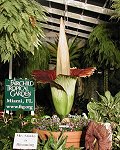| Steinway and Sons celebrates the 150th anniversary of its pianos | |
| http://www.sina.com.cn 2004/08/31 12:50 新浪教育 | |
语音讲解: AMERICAN MOSAIC - June 27, 2003: Steinway and Sons celebrates the 150th anniversary of its pianos / A question from China about American slang / A rare and foul smelling plant brings a crowd in Florida (THEME) HOST: Welcome to AMERICAN MOSAIC -- VOA’s radio magazine in Special English. (THEME) This is Doug Johnson. On our program today: We answer a question about American slang ... We listen to what music played on a Steinway piano sounds like ... And we report about a rare and foul smelling plant. Mister Stinky HOST:
Crowds of people recently visited a garden center in Florida to see a rare plant put on a show. This Amorphophallus titanum [a-more-fo-FAIL-us TIE-tan-um) plant grows in the rain forests of Sumatra, Indonesia. People there call it a “corpse flower," since it smells like something died. Shep O’Neal tells us about it. ANNCR: Workers and visitors at the Fairchild Tropical Garden in Coral Gables, in the Miami area, call the plant “Mister Stinky." Many visitors held their noses when they gathered near. But some stayed close for hours to watch it bloom. Scientists say very few of its kind have ever flowered in the United States. Mister Stinky first developed a yellowish green flower. It looked like a bell that had been turned over. This flower grew to a height of more than two meters within three weeks. The Amorphophallus titanum flower is often called the world’s largest flower. But experts say it is really a collection of many smaller ones. The flower lives only about two or three days. The garden let the public know that Mister Stinky was about to flower for the third time since it went on show in June of nineteen-ninety-eight. Garden expert Craig Allen says the smell results from chemicals that heat the flower. These chemicals invite insects to provide pollen to the flower. Some plants, like orchids, have pleasant smells that get bees and other insects to pollinate them. But Mister Allen says that in the rainforest, the stinky plant might have to invite an insect from far away. A strong smell is a much better way to appeal to a carrion beetle, which looks for dead animals. Since that, as Mister Allen says, is pretty much what Mister Stinky smells like. In August of nineteen-ninety-nine, thousands of people smelled an Amorphorphallus titanum in California. The plant flowered at the Huntington Botanical Gardens in San Marino. The following spring, scientists at the garden produced seeds from the plant. As far as we know, Germany holds the record for the biggest smelly flower. Earlier this month, thousands of people saw an Amorphophallus titanum flower at the University of Bonn. It measured about two- and-one-half meters. Slang HOST: Our VOA listener question this week comes from China. Zhang Lui asks about slang. Slang is language that is different from the kind of speech that we are taught in school. Slang expresses ideas using new terms, or gives new meanings to old ones. One expert says good slang uses very few words to communicate a lot of meaning. Dictionaries say no is sure where the word "slang" itself came from, but some say it dates back to the seventeen-hundreds.
American slang is born in the everyday speech of different groups. Television, movies and radio spread the new words or expressions to other groups. For example, black culture has given the language expressions such as to “bad mouth,” meaning to criticize someone. Teenage culture produces a lot of slang words, too. One is “mallie,” a person who spends a lot of time in shopping malls. People in business also have created slang expressions. One example is “red eye,” an all-night airplane flight from coast to coast. Most slang words disappear after a time. The phrase “right on,” for example, was often used in the nineteen-sixties and seventies to mean “that is correct” or “I agree.” Not many people use it these days. In nineteen-ninety-four, University of Tennessee professor Jonathan Lighter published the first book in a series called the Historical Dictionary of American Slang. It gave the meaning of slang words that start with the letter A through the letter G. Three years later, he published the second book. It begins with H and ends with O. It contains ten-thousand entries. These include slang terms that use names. Some are very unusual. One example is “Monet,” after the French painter Claude Monet. The word describes someone who looks good from far away but is not as good looking up close. The book also includes three pages of slang that use the name “Joe.” “Joe Lunchpail” is a working man. “Joe Sad” is someone who has no friends. Random House published the first two books. Now Oxford University Press has taken over the project. It plans to publish two more books to complete the Historical Dictionary of American Slang. The next one is expected in two-thousand-six. Steinway And Sons (MUSIC) HOST:
That is pianist Arthur Rubenstein playing Schumann’s “Arabeske” on a Steinway piano. Steinway and Sons is one of the most famous makers of pianos in the world. The company is celebrating its one-hundred-fiftieth birthday this year. It is offering free tours of its factory in New York and holding special concerts at Carnegie Hall. It is also working with other companies to celebrate the anniversary. For example, the Steiff North America company is creating a toy to be known as Henry the Steinway Bear. Steve Ember tells us about Steinway and Sons. AP ANNCR: The story really begins three-hundred years ago in Italy when Bartolomeo Cristofori invented the piano. The story of Steinway and Sons begins in Seesen, Germany, in the eighteen-hundreds. Heinrich Steinwig owned a company that produced musical instruments. He and his family moved to the United States in eighteen-fifty. Heinrich changed his last name to Steinway to make it sound more American.
The family started its own business in eighteen-fifty-three. It was an immediate success. Steinway and Sons won prizes at World’s Fairs for its new piano designs and sound. The company developed technical changes in the piano. In eighteen-seventy-five, Theodore Steinway created the modern grand piano. William Steinway helped establish the company’s fame. He brought pianists to the United States to play concerts on Steinway grand pianos. Since then, many famous piano performers have used Steinways. One of the most famous is Vladimir Horowitz. Here he plays a Steinway in a recording of Chopin’s Polonaise. (MUSIC) Today, Steinway produces about five-thousand pianos a year. The company says more than one-thousand concert pianists use Steinway pianos. These include Van Cliburn, Harry Connick Junior, Billy Joel, Diana Krall, James Levine, and Randy Newman. We leave you now with another of these Steinway artists, Roger Williams. Here, he plays “Autumn Leaves.” (MUSIC) HOST: This is Doug Johnson. I hope you enjoyed our program today. This program was written by Nancy Steinbach and Jerilyn Watson. Our studio engineer was Roy Benson. And the producer was Paul Thompson. Join us again next week for AMERICAN MOSAIC -- VOA’s radio magazine in Special English. 出处:《美国之音慢速英语经典》系列光盘产品 BiCulture工作室(www.biculture.com)
| |
【评论】 |
| 【英语学习论坛】【大 中 小】【打印】【关闭】 |



